Climate change poses one of the most pressing challenges of our time, with rising carbon dioxide (CO2) levels driving global warming and environmental instability. Amidst this crisis, CO2 Direct Air Capture (DAC) technology has emerged as a promising solution to mitigate emissions and restore atmospheric balance. By extracting CO2 directly from the air, DAC offers a pathway to sustainable agriculture and energy systems, enabling carbon-neutral or even carbon-negative practices. This article explores the transformative potential of DAC in addressing climate change, its integration into agricultural and energy sectors, and the challenges and opportunities it presents in the global pursuit of a sustainable future.

- The Role of CO2 Direct Air Capture in Combating Climate Change: A Path Toward Sustainable Agriculture and Energy
- How capturing CO2 from air can combat climate change?
- How does direct air capture help climate change?
- How does carbon capture help climate change?
- What role does carbon dioxide play in climate change?
- Frequently Asked Questions (FAQ)
The Role of CO2 Direct Air Capture in Combating Climate Change: A Path Toward Sustainable Agriculture and Energy
Direct Air Capture (DAC) of CO2 is emerging as a critical technology in the fight against climate change. By removing carbon dioxide directly from the atmosphere, DAC offers a pathway to reduce greenhouse gas concentrations, mitigate global warming, and support sustainable practices in agriculture and energy production. This technology not only helps in achieving climate goals but also provides opportunities for carbon utilization in various industries, fostering a circular carbon economy.
Understanding CO2 Direct Air Capture Technology
Direct Air Capture (DAC) involves the use of advanced chemical processes to extract CO2 directly from ambient air. Unlike traditional carbon capture methods that focus on point sources like power plants, DAC can be deployed anywhere, making it a versatile tool for global carbon reduction. The captured CO2 can either be stored underground or utilized in industrial applications, such as producing synthetic fuels or enhancing agricultural productivity.
See Also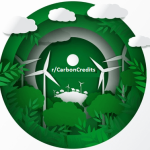 Are Carbon Offset Projects Continuously Monitored by Satellite? Are There Insurance Products to Protect These Areas?
Are Carbon Offset Projects Continuously Monitored by Satellite? Are There Insurance Products to Protect These Areas?| Key Component | Function |
|---|---|
| Air Contactors | Large fans or structures that draw in ambient air for CO2 extraction. |
| Chemical Sorbents | Materials that selectively bind with CO2 molecules from the air. |
| Regeneration Process | Heating or chemical treatment to release captured CO2 for storage or use. |
Benefits of DAC for Sustainable Agriculture
DAC can play a transformative role in agriculture by providing a sustainable source of CO2 for greenhouse enrichment. Enhanced CO2 levels in controlled environments can boost crop yields, improve plant resilience, and reduce water usage. Additionally, DAC-derived CO2 can be used to produce biofertilizers, further supporting eco-friendly farming practices.
| Application | Impact |
|---|---|
| Greenhouse Enrichment | Increases photosynthesis rates, leading to higher crop yields. |
| Biofertilizer Production | Reduces dependency on chemical fertilizers, promoting soil health. |
DAC's Contribution to Renewable Energy Integration
The integration of DAC with renewable energy sources, such as solar and wind, can create a synergistic relationship. Excess renewable energy can power DAC facilities, ensuring efficient and low-cost CO2 capture. This approach not only reduces the carbon footprint of energy production but also supports grid stability by balancing supply and demand.
| Renewable Energy Source | Role in DAC |
|---|---|
| Solar Power | Provides clean energy for DAC operations during daylight hours. |
| Wind Energy | Supplies power for DAC during periods of high wind availability. |
Economic and Environmental Challenges of DAC
Despite its potential, DAC faces significant challenges, including high costs and energy requirements. Scaling up the technology requires substantial investment and innovation to make it economically viable. Additionally, the environmental impact of DAC facilities, such as land use and resource consumption, must be carefully managed to ensure net-positive outcomes.
See Also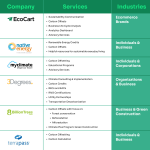 How Common Are Carbon Offsetting Programs in Large Businesses?
How Common Are Carbon Offsetting Programs in Large Businesses?| Challenge | Consideration |
|---|---|
| High Costs | Current DAC technologies are expensive, requiring subsidies or carbon pricing to be competitive. |
| Energy Intensity | DAC processes consume significant energy, necessitating renewable energy integration. |
Policy and Global Collaboration for DAC Adoption
The widespread adoption of DAC requires robust policy frameworks and international cooperation. Governments must incentivize DAC development through funding, tax credits, and carbon pricing mechanisms. Global collaboration is essential to share knowledge, standardize technologies, and ensure equitable access to DAC benefits, particularly for developing nations.
| Policy Measure | Impact |
|---|---|
| Carbon Pricing | Encourages investment in DAC by making carbon emissions more costly. |
| Research Funding | Supports innovation and cost reduction in DAC technologies. |
How capturing CO2 from air can combat climate change?
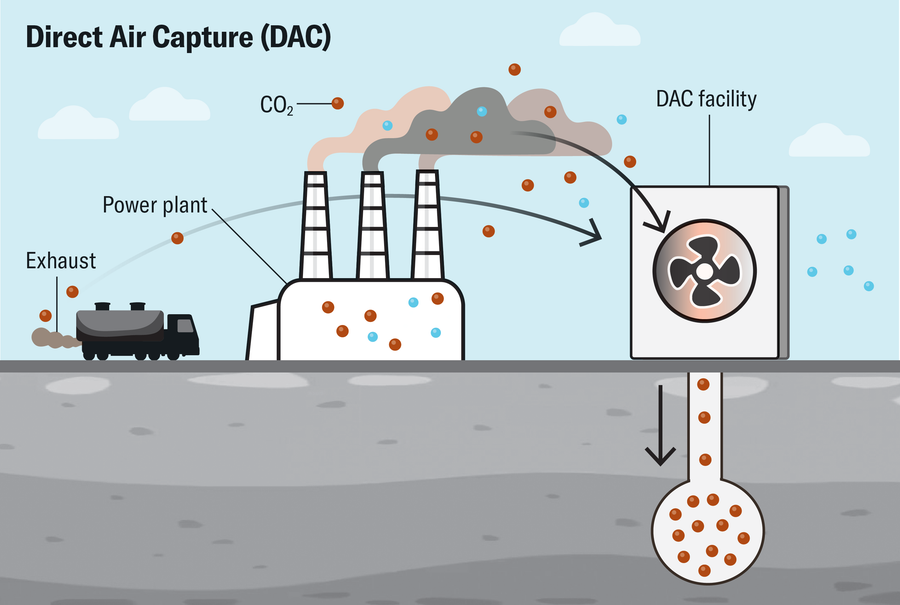
How Does Direct Air Capture (DAC) Technology Work?
Direct Air Capture (DAC) technology is a method designed to remove carbon dioxide (CO2) directly from the atmosphere. This process involves large-scale machines that use chemical reactions to capture CO2 from ambient air. The captured CO2 can then be stored underground or used in industrial processes. Here’s how it works:
See Also How Can I Break into This Field With Experience From Commodity Field and Currently Pursuing a Masters in Zero Carbon Tech
How Can I Break into This Field With Experience From Commodity Field and Currently Pursuing a Masters in Zero Carbon Tech- Air intake: Large fans draw in ambient air, which contains CO2.
- Chemical absorption: The air passes through a filter or liquid solution that chemically binds with CO2 molecules.
- CO2 separation: The captured CO2 is separated from the filter or solution using heat or pressure.
- Storage or utilization: The purified CO2 is either stored underground in geological formations or used in products like fuels or building materials.
Why Is Capturing CO2 from Air Important for Climate Change?
Capturing CO2 from the air is crucial because it addresses the root cause of climate change: excessive greenhouse gas emissions. Even if we reduce emissions, existing CO2 in the atmosphere will continue to warm the planet. Here’s why this process is vital:
- Reduces atmospheric CO2 levels: It directly lowers the concentration of CO2, a major greenhouse gas.
- Complements emission reductions: It works alongside efforts to cut emissions, providing a dual approach to combating climate change.
- Helps achieve net-zero goals: It enables industries and countries to offset hard-to-eliminate emissions.
What Are the Benefits of CO2 Capture for the Environment?
CO2 capture from the air offers several environmental benefits that contribute to a healthier planet. These include:
- Mitigates global warming: By removing CO2, it reduces the greenhouse effect and slows temperature rise.
- Improves air quality: Lower CO2 levels can indirectly reduce other pollutants linked to fossil fuel use.
- Supports ecosystems: Reducing CO2 helps stabilize climate conditions, benefiting biodiversity and natural habitats.
What Are the Challenges of Capturing CO2 from Air?
While CO2 capture is promising, it faces several challenges that need to be addressed for widespread adoption. These include:
- High costs: The technology is currently expensive due to energy requirements and infrastructure needs.
- Energy consumption: DAC systems require significant energy, which must come from renewable sources to be sustainable.
- Scalability: Scaling up the technology to capture billions of tons of CO2 annually is a logistical and financial challenge.
How Can Captured CO2 Be Utilized Effectively?
Captured CO2 can be used in various ways to create economic value while reducing emissions. Here are some effective utilization methods:
- Carbon-neutral fuels: CO2 can be combined with hydrogen to produce synthetic fuels for transportation.
- Building materials: CO2 can be used to create concrete or other construction materials, locking it away permanently.
- Industrial applications: It can be used in the production of chemicals, plastics, or fertilizers, reducing the need for fossil fuel-derived CO2.
How does direct air capture help climate change?
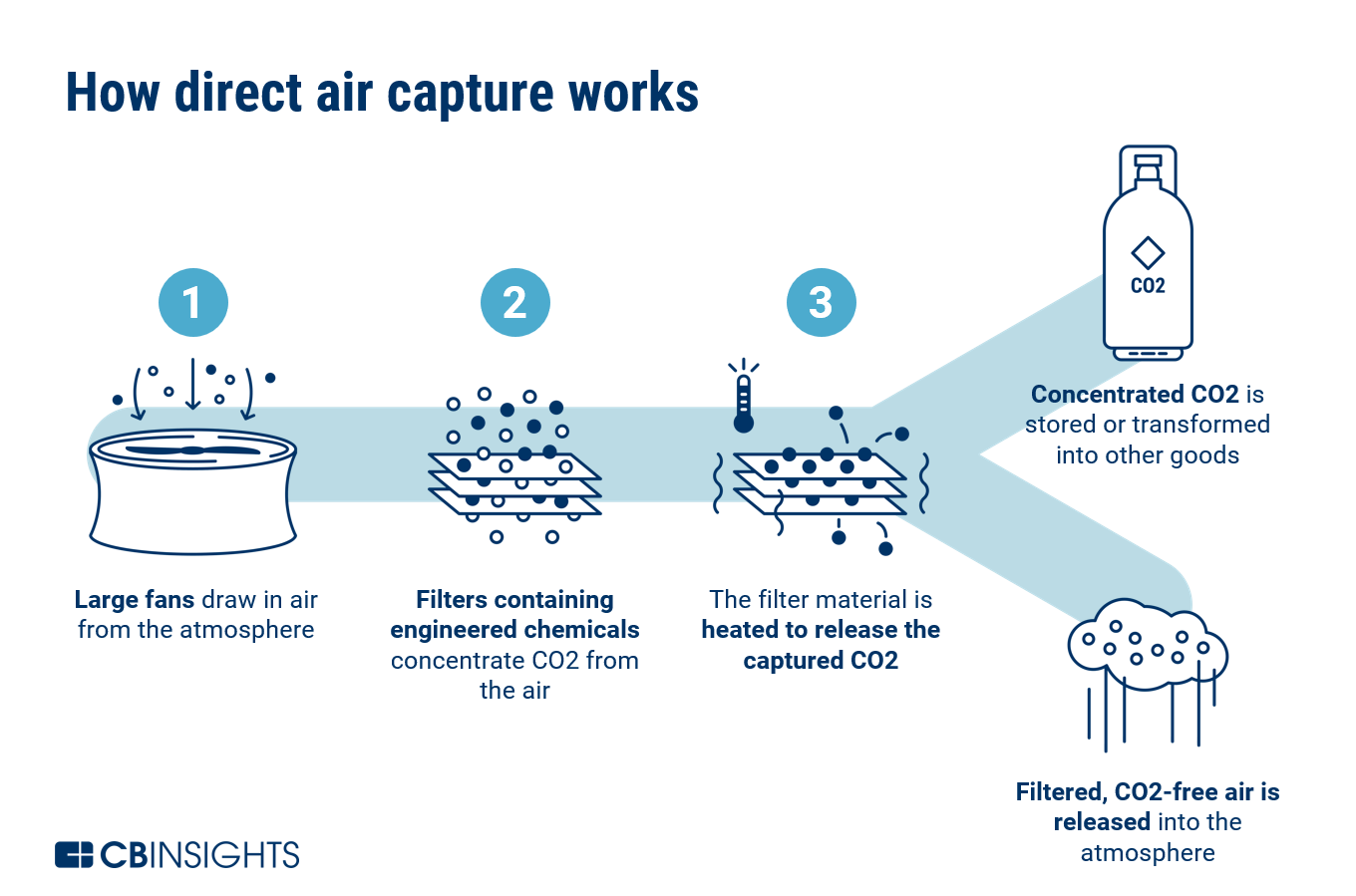
What is Direct Air Capture?
Direct Air Capture (DAC) is a technology designed to remove carbon dioxide (CO₂) directly from the atmosphere. It uses chemical processes to capture CO₂, which can then be stored underground or utilized in various industrial applications. This method is particularly significant because it targets existing greenhouse gases in the air, complementing efforts to reduce emissions.
- DAC systems use large fans to draw in air and pass it through chemical filters.
- The captured CO₂ is then separated and purified for storage or use.
- This process is energy-intensive but can be powered by renewable energy sources to minimize its carbon footprint.
How Does DAC Reduce Greenhouse Gases?
Direct Air Capture helps reduce greenhouse gases by physically removing CO₂ from the atmosphere. Unlike traditional methods that focus on preventing new emissions, DAC addresses the legacy carbon already present, which is crucial for achieving long-term climate goals.
- DAC can capture CO₂ from any location, making it a versatile solution.
- It complements other carbon reduction strategies, such as reforestation and renewable energy adoption.
- By reducing atmospheric CO₂ levels, DAC helps mitigate the greenhouse effect and slow global warming.
What Are the Environmental Benefits of DAC?
Direct Air Capture offers several environmental benefits, including the potential to reverse climate change impacts by lowering atmospheric CO₂ concentrations. It also provides a way to achieve negative emissions, which are essential for meeting international climate targets.
- DAC can help restore balance to ecosystems affected by high CO₂ levels.
- It supports biodiversity by reducing the acidification of oceans caused by excess CO₂.
- The technology can be scaled to meet global carbon removal needs.
What Are the Challenges of Implementing DAC?
Despite its potential, Direct Air Capture faces several challenges, including high costs and energy requirements. These factors currently limit its widespread adoption, but ongoing research and innovation aim to address these barriers.
- The technology requires significant investment in infrastructure and development.
- Energy consumption is a major concern, though renewable energy can offset this.
- Public and private sector collaboration is needed to scale DAC effectively.
How Can DAC Be Integrated into Climate Policy?
Direct Air Capture can play a critical role in climate policy by providing a measurable way to achieve carbon neutrality and negative emissions. Governments and organizations can incorporate DAC into their strategies to meet international climate agreements like the Paris Accord.
- Policies can incentivize DAC development through subsidies and carbon pricing.
- International cooperation can help standardize DAC technologies and practices.
- DAC can be integrated into broader climate action plans to enhance their effectiveness.
How does carbon capture help climate change?
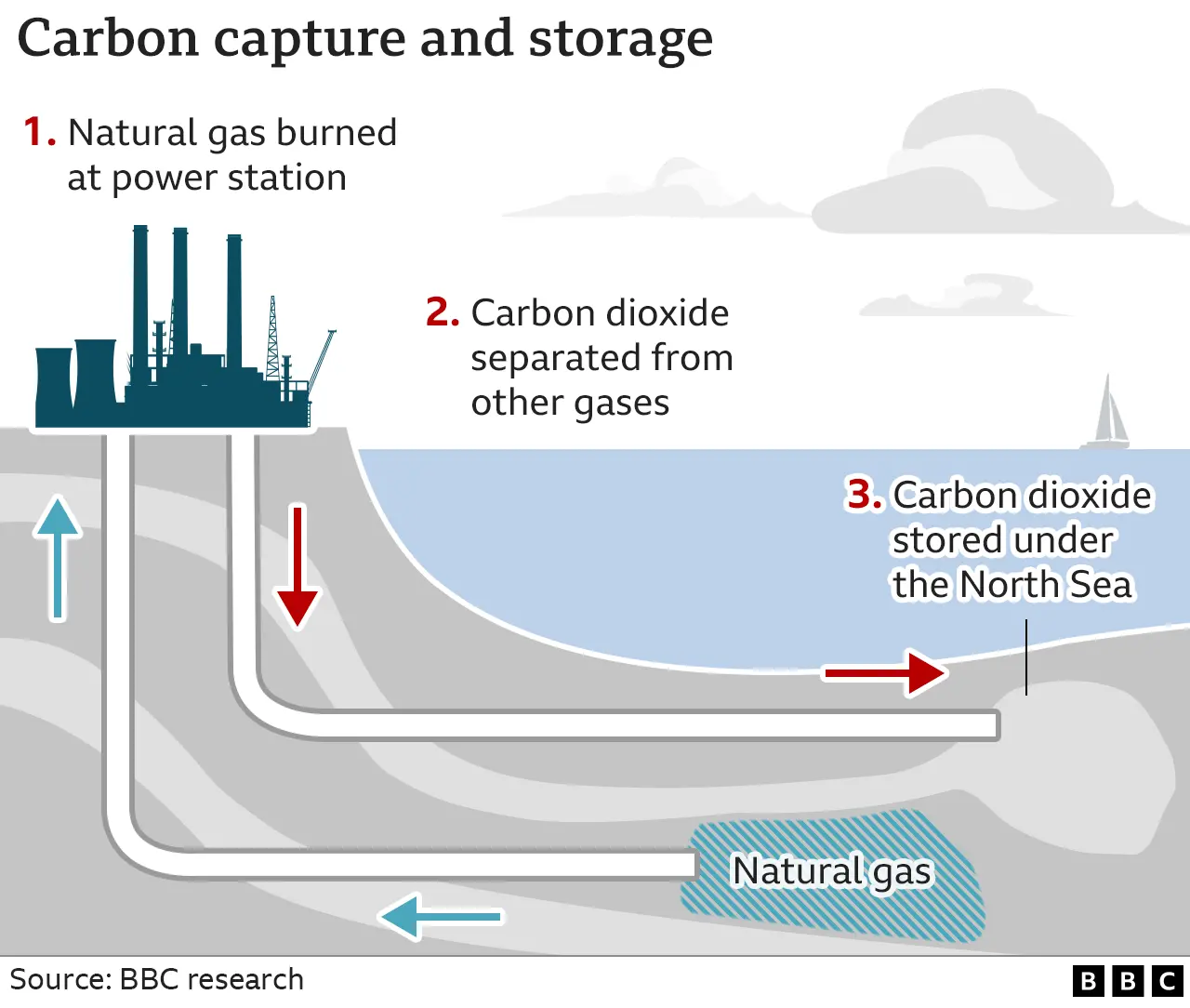
What is Carbon Capture and How Does It Work?
Carbon capture is a technology designed to reduce greenhouse gas emissions by capturing carbon dioxide (CO2) from industrial processes or directly from the atmosphere. The process involves three main steps:
- Capture: CO2 is separated from other gases produced during industrial processes, such as power generation or cement production.
- Transport: The captured CO2 is compressed and transported via pipelines or ships to a storage site.
- Storage: The CO2 is injected deep underground into geological formations, where it is stored permanently to prevent it from entering the atmosphere.
How Does Carbon Capture Reduce Greenhouse Gas Emissions?
Carbon capture helps mitigate climate change by preventing CO2 from being released into the atmosphere. This is achieved through:
- Reducing emissions from industrial sources: By capturing CO2 from factories, power plants, and other industrial facilities, the technology directly lowers the amount of greenhouse gases emitted.
- Enhancing natural carbon sinks: Some carbon capture methods involve using captured CO2 to enhance natural processes, such as reforestation or soil carbon sequestration.
- Offsetting hard-to-abate emissions: Industries like aviation and shipping, which are difficult to decarbonize, can use carbon capture to offset their emissions.
What Are the Different Types of Carbon Capture Technologies?
There are several methods of carbon capture, each suited to different applications:
- Post-combustion capture: This method captures CO2 from exhaust gases after fossil fuels are burned, commonly used in power plants.
- Pre-combustion capture: CO2 is removed before combustion by converting fossil fuels into a mixture of hydrogen and CO2, which is then separated.
- Direct air capture (DAC): This technology extracts CO2 directly from the atmosphere, making it useful for reducing existing atmospheric CO2 levels.
What Are the Benefits of Carbon Capture for Climate Change?
Carbon capture offers several advantages in the fight against climate change:
- Immediate impact: It can be deployed quickly to reduce emissions from existing infrastructure without requiring a complete overhaul of energy systems.
- Versatility: It can be applied across various industries, including energy, manufacturing, and transportation.
- Support for renewable energy transition: Carbon capture can complement renewable energy by addressing emissions from sectors that are harder to decarbonize.
What Are the Challenges of Implementing Carbon Capture?
Despite its potential, carbon capture faces several challenges:
- High costs: The technology is expensive to develop and implement, requiring significant investment.
- Energy requirements: Capturing and storing CO2 consumes energy, which can reduce the overall efficiency of the process.
- Infrastructure needs: Building pipelines and storage facilities requires substantial planning and resources.
What role does carbon dioxide play in climate change?

The Greenhouse Effect and Carbon Dioxide
Carbon dioxide (CO₂) is a greenhouse gas that plays a critical role in the Earth's climate system. It traps heat in the atmosphere, contributing to the greenhouse effect. Without CO₂, the planet would be too cold to support life. However, excessive amounts of CO₂, primarily from human activities like burning fossil fuels and deforestation, have intensified this effect, leading to global warming.
- CO₂ absorbs and re-emits infrared radiation, trapping heat in the atmosphere.
- Human activities have increased atmospheric CO₂ levels by over 50% since the Industrial Revolution.
- This excess CO₂ disrupts the natural balance of the greenhouse effect, causing temperatures to rise.
Carbon Dioxide and Global Temperature Rise
The increase in atmospheric CO₂ levels is directly linked to the rise in global temperatures. As CO₂ concentrations grow, more heat is retained, leading to a phenomenon known as global warming. This warming affects weather patterns, sea levels, and ecosystems worldwide.
- Higher CO₂ levels correlate with increased global average temperatures.
- Since the late 19th century, Earth's average temperature has risen by approximately 1.2°C.
- This warming accelerates the melting of polar ice caps and glaciers, contributing to sea level rise.
Carbon Dioxide's Impact on Ocean Acidification
CO₂ not only affects the atmosphere but also has significant consequences for the oceans. When CO₂ dissolves in seawater, it forms carbonic acid, leading to ocean acidification. This process harms marine life, particularly organisms with calcium carbonate shells or skeletons, such as corals and shellfish.
- Approximately 25% of emitted CO₂ is absorbed by the oceans.
- Ocean acidification reduces the availability of carbonate ions, essential for shell formation.
- This threatens marine biodiversity and disrupts food chains.
Carbon Dioxide and Extreme Weather Events
The accumulation of CO₂ in the atmosphere contributes to more frequent and severe extreme weather events. These include heatwaves, droughts, heavy rainfall, and hurricanes. The increased energy in the climate system intensifies these events, causing widespread damage and economic losses.
- Higher temperatures increase the likelihood of heatwaves and droughts.
- Warmer air holds more moisture, leading to heavier rainfall and flooding.
- Rising sea surface temperatures fuel stronger hurricanes and tropical storms.
Carbon Dioxide's Role in Feedback Loops
CO₂ contributes to climate feedback loops, which can amplify the effects of global warming. For example, melting permafrost releases additional CO₂ and methane, further accelerating climate change. These feedback loops create a cycle that is difficult to break without significant intervention.
- Melting ice reduces the Earth's albedo, causing more heat absorption.
- Thawing permafrost releases stored greenhouse gases, increasing atmospheric concentrations.
- Deforestation reduces the planet's capacity to absorb CO₂, exacerbating the problem.
Frequently Asked Questions (FAQ)
What is CO2 Direct Air Capture and how does it work?
CO2 Direct Air Capture (DAC) is a technology designed to remove carbon dioxide (CO2) directly from the atmosphere. It works by using large-scale machines equipped with chemical filters that absorb CO2 from the air. Once captured, the CO2 can be stored underground in geological formations or utilized in various industrial processes, such as producing synthetic fuels or enhancing sustainable agriculture. This technology is particularly important in combating climate change as it helps reduce the overall concentration of greenhouse gases in the atmosphere.
How can CO2 Direct Air Capture contribute to sustainable agriculture?
CO2 Direct Air Capture can play a significant role in promoting sustainable agriculture by providing a source of carbon dioxide for use in greenhouse farming. Captured CO2 can be pumped into greenhouses to enhance plant growth, increasing crop yields and improving food security. Additionally, the technology supports carbon-neutral farming practices by offsetting emissions from agricultural activities. This integration of DAC into agriculture helps create a more resilient and sustainable food system while addressing climate challenges.
What are the energy requirements for CO2 Direct Air Capture systems?
CO2 Direct Air Capture systems require significant amounts of energy to operate, primarily for powering the fans that draw in air and the processes that separate CO2 from the filters. The energy demand can be a challenge, but using renewable energy sources, such as solar or wind power, can make the process more sustainable. By coupling DAC with clean energy, the technology can achieve a net-negative carbon footprint, making it a viable solution for long-term climate mitigation.
What are the challenges and limitations of CO2 Direct Air Capture?
While CO2 Direct Air Capture holds promise, it faces several challenges and limitations. The technology is currently expensive to implement and requires substantial infrastructure investments. Additionally, the energy-intensive nature of the process can limit its scalability unless powered by renewable energy. There are also concerns about the long-term storage of captured CO2 and potential environmental impacts. Despite these challenges, ongoing research and innovation are expected to improve the efficiency and affordability of DAC, making it a critical tool in the fight against climate change.
Leave a Reply

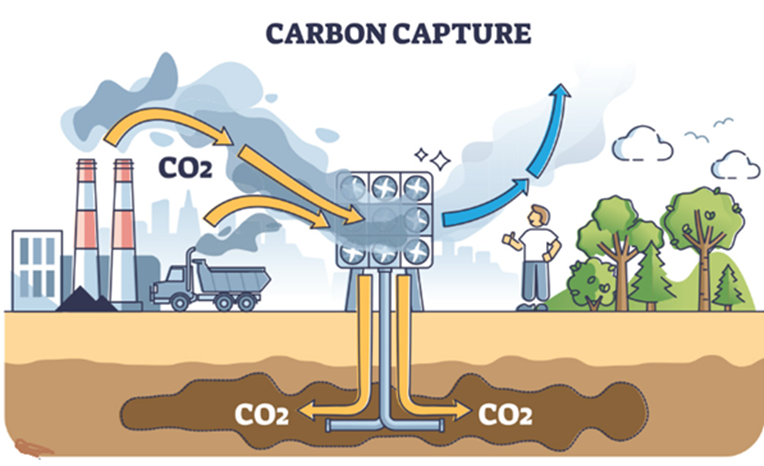
Our Recommended Articles